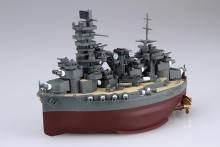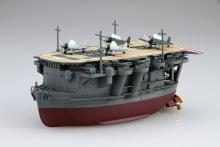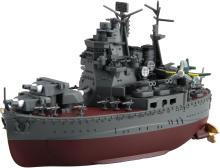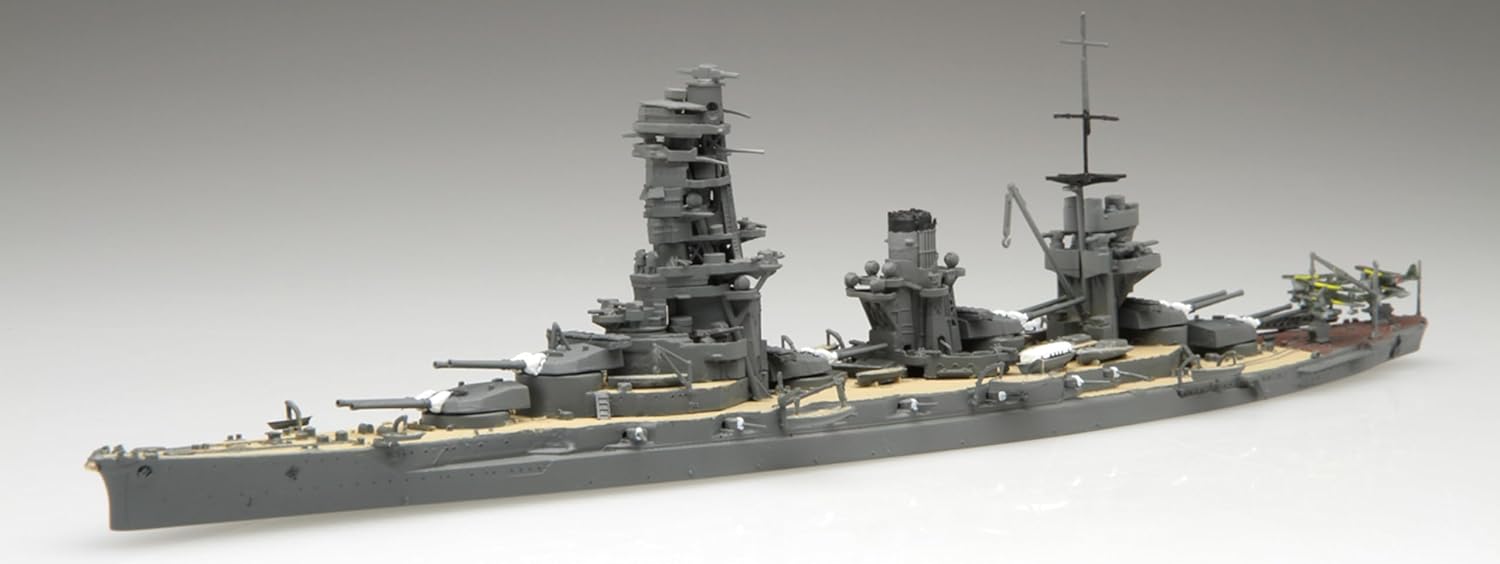Shipping and Returns
Europe, UK: Thursday, Nov 13
USA: Tuesday, Nov 11
Australia: Thursday, Nov 13
Asia: Wednesday, Nov 12
UAE: Thursday, Nov 13
Order within 15 Hours 0 mins with Scheduled Delivery. If you place an order within this time, We will ship on Monday, Nov 10 2025. This delivery time is calculated by DHL & Fedex. You can check the exact delivery date on checkout page.
USA: Tuesday, Nov 11
Australia: Thursday, Nov 13
Asia: Wednesday, Nov 12
UAE: Thursday, Nov 13
Order within 15 Hours 0 mins with Scheduled Delivery. If you place an order within this time, We will ship on Monday, Nov 10 2025. This delivery time is calculated by DHL & Fedex. You can check the exact delivery date on checkout page.
Buyer Protection
Full refund if not genuine. Full or partial refund, if the new item is not as described.
Customer Reviews (0 rating)
No reviews on this item...
Description (8,421 characters)
Plastic Models
[Scale] 1/700
Product introduction You can choose between the appearance at the start of the war and the Battle of Leyte Gulf, and new parts are added to reproduce the detailed appearance! The product is an unpainted kit that requires assembly and painting.
The scale is 1/700, and the offshore model does not include the bottom of the ship.
This product is made up of a conventional (special series) mold and newly designed additional parts.
The battleship Yamashiro was built at Yokosuka Naval Arsenal as the second Fuso-class battleship and was completed in 1917.
Although it was the oldest type of ship at the start of the Pacific War, it underwent modernization in the Showa era, with improvements to its defense and speed being made.
At that time, the outfitting style of the No. 3 turret/flywater scout launcher was different from that of the first ship, Fuso, and so the silhouettes of the two sister ships were different.
The ship was equipped with 12 main guns, six 35.6 cm twin guns, and had a standard displacement of 34,500 tons, but with a 75,000 horsepower engine, it could reach a speed of 24.5 knots.
From the beginning of the war until the middle of it, the ship was not blessed with many opportunities to go on missions, but in October 1944, in response to the US military landing on the Philippines, it went on missions as the flagship of the 3rd Unit of the 1st Striking Force (Nishimura Fleet), but was sunk in battle by an attack from a group of American ships waiting for it in the Surigao Strait.
・Products can be manufactured in three different annual shapes.
- The ship was equipped with an external electric cable and was ready to go, but it was not equipped with a radar or additional machine guns, as it appeared at the start of the war in 1941.
・The aircraft in the first half of 1944, when the number of machine guns had increased and the No. 21 radar was installed.
・The number of machine guns was increased to the maximum, and the No. 21 radar was removed and the No. 13 radar was installed during Operation Sho-Ichi.
Newly designed parts are available to standardize the differences in the reproduction of equipment, etc. depending on the product release date, and some parts are divided to take painting into consideration. The No. 13 radar is a new enclosed part with a truss structure and a sculptured antenna shape.
The No. 21 radar is depicted with more delicate engravings than previous accessory parts, such as the insulator base for fixing the element on the front side.
・The No. 22 radar can be made into an open part by using a slide mold, and it is also possible to make it into a trumpet-shaped extended shape.
・The 12.7cm twin anti-aircraft gun A-type is divided into 4 parts, with improved modeling resolution compared to the existing 2 parts.
The 9m cutter is made into two parts for painting, and the stand is available as a separate part, or you can choose to use the deck as a one-piece mold.
(Excluding some parts) ・The canvas, wheelhouse and engine room canopy of the 12m motorboat are separate parts to allow for painting.
Each painting is done and assembly and bonding are done later.
・The 12m internal fire launch can now be expressed without the canvas
- The shipboard stand has a molded uneven shape and light holes, giving it a more precise appearance.
-New chrysanthemum crest on the bow
- Newly prepared port lights, for additional expression in areas that were previously omitted
- Added decals for the ship name on the stern (painted in battleship colors) and the white lines on the mast
- The Type 96 25mm twin machine gun is now standardly made of two parts, reducing the amount of painting required.
- Binocular telescope parts added to each floor of the bridge
Hull: The starboard and port sides of the hull are one-piece molded parts.
- The sides of the ship are detailed with detailed carvings of external electrical wiring all around the hull.
・The bow fairlead and chrysanthemum crest are separate parts
Deck - The upper deck is a single piece, and the wooden deck and the linoleum deck at the stern are engraved with details to enhance the sense of detail.
- Capstans and hose reels are depicted as integral sculptures on the deck.
・The bridge base (bridge deck) is a one-piece structure part made by a slide mold
Bridge: In order to recreate a shape different from that of the first ship, Fuso, parts exclusive to Yamashiro were used.
- The bridge is constructed by stacking and assembling each layer, allowing you to recreate its unique shape.
- Each floor of the bridge is fitted with detailed equipment, including a binocular telescope.
- Separate parts are provided to express differences between the early and later stages of the war, such as the presence or absence of windbreaks and the enlarged battle bridge.
- You can now choose whether to use the No. 21 radar or not, and the No. 22 radar can be recreated as the extended type seen in the later stages of the war.
Main gun, secondary gun, barrel and turret are separate parts, and the barrel can be assembled at any angle.
The barrel and waterproof canvas are one piece, and the muzzle is open using a slide mold.
- The range finder on the turret has a separate cover and upper part, making it closer to the actual shape.
・The machine gun mounts added to the 2nd, 3rd, 4th and 5th main gun canopies are reproduced with special parts.
- Secondary guns are equipped with integrated barrels and waterproof canvas
Chimney and rear bridge - The chimney is made of two parts, left and right, glued together.
- Steam exhaust pipe is a separate part to enhance the sense of precision.
-Waterproof canvas cover is removed
-Special parts are available to recreate the changes in the shape of the lookout post during the latter stages of the war, such as the addition of the No. 13 radar.
- Parts are available to correspond to the annual difference between the 1941 3.5m rangefinder and the 1944 Type 94 compass.
Mast, aircraft equipment, etc. - Seaplane lifting crane is reproduced in upright position
- Two types of rear mast cross trees are included, with or without No. 13 radar.
- The 25mm machine gun is a two-part model with a precise design and an easy-to-paint structure, and the 2018 model mold parts are included as standard.
- The molding color of the main parts, the ship's bottom plate, the aircraft carrier, the machine gun parts, etc. are molded in gray.
-The molding color is gray to improve workability (to prevent damage when cutting the gate).
- Three Type 95 seaplanes were included for use at the start of the war in 1941.
- Two Zero type seaplanes are included for use in 1944.
- Two types of decals are included - Decals including naval ensigns, the Japanese flag, and carrier-based aircraft markings
・Military flags are available in three sizes
Includes 1/700 scale versions of the actual 10 width, 6 width, and 3 width sizes.
- Includes the Hinomaru flag of carrier-based aircraft, friendly identification belt (yellow belt), etc., and the Hinomaru flag also includes the one without the white border from the later period of the war.
- Decals containing draft markings, the chrysanthemum crest on the bow, and the ship's name on the stern (in two colors: gold and solid in warship colors)
[Included Contents] ・Runners x 53 ・Assembly instructions x 1 ・Decals x 3 *This product is made in Japan
*This product is a plastic model kit that requires assembly.
Safety Warning: None
Dimensions: 41 x 15 x 6 cm
Tags:
[Scale] 1/700
Product introduction You can choose between the appearance at the start of the war and the Battle of Leyte Gulf, and new parts are added to reproduce the detailed appearance! The product is an unpainted kit that requires assembly and painting.
The scale is 1/700, and the offshore model does not include the bottom of the ship.
This product is made up of a conventional (special series) mold and newly designed additional parts.
The battleship Yamashiro was built at Yokosuka Naval Arsenal as the second Fuso-class battleship and was completed in 1917.
Although it was the oldest type of ship at the start of the Pacific War, it underwent modernization in the Showa era, with improvements to its defense and speed being made.
At that time, the outfitting style of the No. 3 turret/flywater scout launcher was different from that of the first ship, Fuso, and so the silhouettes of the two sister ships were different.
The ship was equipped with 12 main guns, six 35.6 cm twin guns, and had a standard displacement of 34,500 tons, but with a 75,000 horsepower engine, it could reach a speed of 24.5 knots.
From the beginning of the war until the middle of it, the ship was not blessed with many opportunities to go on missions, but in October 1944, in response to the US military landing on the Philippines, it went on missions as the flagship of the 3rd Unit of the 1st Striking Force (Nishimura Fleet), but was sunk in battle by an attack from a group of American ships waiting for it in the Surigao Strait.
・Products can be manufactured in three different annual shapes.
- The ship was equipped with an external electric cable and was ready to go, but it was not equipped with a radar or additional machine guns, as it appeared at the start of the war in 1941.
・The aircraft in the first half of 1944, when the number of machine guns had increased and the No. 21 radar was installed.
・The number of machine guns was increased to the maximum, and the No. 21 radar was removed and the No. 13 radar was installed during Operation Sho-Ichi.
Newly designed parts are available to standardize the differences in the reproduction of equipment, etc. depending on the product release date, and some parts are divided to take painting into consideration. The No. 13 radar is a new enclosed part with a truss structure and a sculptured antenna shape.
The No. 21 radar is depicted with more delicate engravings than previous accessory parts, such as the insulator base for fixing the element on the front side.
・The No. 22 radar can be made into an open part by using a slide mold, and it is also possible to make it into a trumpet-shaped extended shape.
・The 12.7cm twin anti-aircraft gun A-type is divided into 4 parts, with improved modeling resolution compared to the existing 2 parts.
The 9m cutter is made into two parts for painting, and the stand is available as a separate part, or you can choose to use the deck as a one-piece mold.
(Excluding some parts) ・The canvas, wheelhouse and engine room canopy of the 12m motorboat are separate parts to allow for painting.
Each painting is done and assembly and bonding are done later.
・The 12m internal fire launch can now be expressed without the canvas
- The shipboard stand has a molded uneven shape and light holes, giving it a more precise appearance.
-New chrysanthemum crest on the bow
- Newly prepared port lights, for additional expression in areas that were previously omitted
- Added decals for the ship name on the stern (painted in battleship colors) and the white lines on the mast
- The Type 96 25mm twin machine gun is now standardly made of two parts, reducing the amount of painting required.
- Binocular telescope parts added to each floor of the bridge
Hull: The starboard and port sides of the hull are one-piece molded parts.
- The sides of the ship are detailed with detailed carvings of external electrical wiring all around the hull.
・The bow fairlead and chrysanthemum crest are separate parts
Deck - The upper deck is a single piece, and the wooden deck and the linoleum deck at the stern are engraved with details to enhance the sense of detail.
- Capstans and hose reels are depicted as integral sculptures on the deck.
・The bridge base (bridge deck) is a one-piece structure part made by a slide mold
Bridge: In order to recreate a shape different from that of the first ship, Fuso, parts exclusive to Yamashiro were used.
- The bridge is constructed by stacking and assembling each layer, allowing you to recreate its unique shape.
- Each floor of the bridge is fitted with detailed equipment, including a binocular telescope.
- Separate parts are provided to express differences between the early and later stages of the war, such as the presence or absence of windbreaks and the enlarged battle bridge.
- You can now choose whether to use the No. 21 radar or not, and the No. 22 radar can be recreated as the extended type seen in the later stages of the war.
Main gun, secondary gun, barrel and turret are separate parts, and the barrel can be assembled at any angle.
The barrel and waterproof canvas are one piece, and the muzzle is open using a slide mold.
- The range finder on the turret has a separate cover and upper part, making it closer to the actual shape.
・The machine gun mounts added to the 2nd, 3rd, 4th and 5th main gun canopies are reproduced with special parts.
- Secondary guns are equipped with integrated barrels and waterproof canvas
Chimney and rear bridge - The chimney is made of two parts, left and right, glued together.
- Steam exhaust pipe is a separate part to enhance the sense of precision.
-Waterproof canvas cover is removed
-Special parts are available to recreate the changes in the shape of the lookout post during the latter stages of the war, such as the addition of the No. 13 radar.
- Parts are available to correspond to the annual difference between the 1941 3.5m rangefinder and the 1944 Type 94 compass.
Mast, aircraft equipment, etc. - Seaplane lifting crane is reproduced in upright position
- Two types of rear mast cross trees are included, with or without No. 13 radar.
- The 25mm machine gun is a two-part model with a precise design and an easy-to-paint structure, and the 2018 model mold parts are included as standard.
- The molding color of the main parts, the ship's bottom plate, the aircraft carrier, the machine gun parts, etc. are molded in gray.
-The molding color is gray to improve workability (to prevent damage when cutting the gate).
- Three Type 95 seaplanes were included for use at the start of the war in 1941.
- Two Zero type seaplanes are included for use in 1944.
- Two types of decals are included - Decals including naval ensigns, the Japanese flag, and carrier-based aircraft markings
・Military flags are available in three sizes
Includes 1/700 scale versions of the actual 10 width, 6 width, and 3 width sizes.
- Includes the Hinomaru flag of carrier-based aircraft, friendly identification belt (yellow belt), etc., and the Hinomaru flag also includes the one without the white border from the later period of the war.
- Decals containing draft markings, the chrysanthemum crest on the bow, and the ship's name on the stern (in two colors: gold and solid in warship colors)
[Included Contents] ・Runners x 53 ・Assembly instructions x 1 ・Decals x 3 *This product is made in Japan
*This product is a plastic model kit that requires assembly.
Safety Warning: None
Dimensions: 41 x 15 x 6 cm
Tags:
FUJIMI Scale model Fujimi Mokei Imperial Japanese Navy 1:700 scale Ship Japanese battleship Fusō Japanese battleship Yamashiro 船・潜水艦 Plastic model kit












